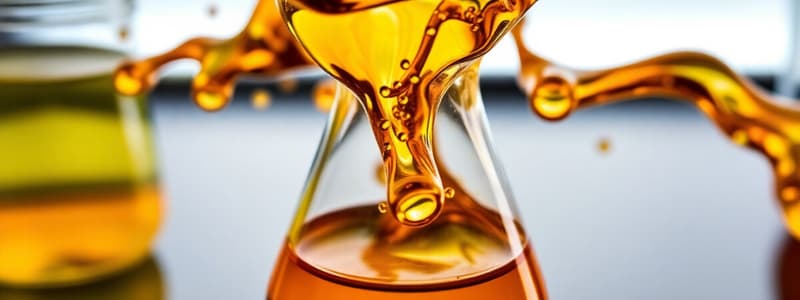Podcast
Questions and Answers
Which process is most likely to result in a decrease in entropy?
Which process is most likely to result in a decrease in entropy?
- Sublimation of dry ice.
- Dissolving sugar in water.
- Condensation of water vapor. (correct)
- Expansion of a gas into a vacuum.
Consider a reaction where two moles of gaseous reactants convert into one mole of gaseous product. What would you expect regarding the change in entropy ($\Delta S$) for this reaction?
Consider a reaction where two moles of gaseous reactants convert into one mole of gaseous product. What would you expect regarding the change in entropy ($\Delta S$) for this reaction?
- $\Delta S$ will be approximately zero, as the number of atoms is conserved.
- $\Delta S$ will be positive if the reaction is exothermic, and negative if endothermic.
- $\Delta S$ will be negative, indicating decreased disorder. (correct)
- $\Delta S$ will be positive, indicating increased disorder.
For the reaction $N_2(g) + 3H_2(g) \rightleftharpoons 2NH_3(g)$, the standard entropies ($S^\circ$) are: $N_2(g)$ = 191.5 J/mol·K, $H_2(g)$ = 130.6 J/mol·K, $NH_3(g)$ = 192.3 J/mol·K. Calculate $\Delta S^\circ$ for this reaction.
For the reaction $N_2(g) + 3H_2(g) \rightleftharpoons 2NH_3(g)$, the standard entropies ($S^\circ$) are: $N_2(g)$ = 191.5 J/mol·K, $H_2(g)$ = 130.6 J/mol·K, $NH_3(g)$ = 192.3 J/mol·K. Calculate $\Delta S^\circ$ for this reaction.
- -62.4 J/mol·K
- -198.3 J/mol·K (correct)
- 198.3 J/mol·K
- 62.4 J/mol·K
A reaction has a positive enthalpy change ($\Delta H > 0$) and a positive entropy change ($\Delta S > 0$). Under what conditions will this reaction be thermodynamically favorable ($\Delta G < 0$)?
A reaction has a positive enthalpy change ($\Delta H > 0$) and a positive entropy change ($\Delta S > 0$). Under what conditions will this reaction be thermodynamically favorable ($\Delta G < 0$)?
A certain reaction is thermodynamically favorable at room temperature but proceeds extremely slowly. What is the most likely reason for this?
A certain reaction is thermodynamically favorable at room temperature but proceeds extremely slowly. What is the most likely reason for this?
Which combination of enthalpy ($\Delta H$) and entropy ($\Delta S$) changes will always result in a thermodynamically favorable reaction ($\Delta G < 0$)?
Which combination of enthalpy ($\Delta H$) and entropy ($\Delta S$) changes will always result in a thermodynamically favorable reaction ($\Delta G < 0$)?
For a reaction at equilibrium, $\Delta G = 0$. If the equilibrium constant K is greater than 1, what can be said about the standard free energy change, $\Delta G^\circ$?
For a reaction at equilibrium, $\Delta G = 0$. If the equilibrium constant K is greater than 1, what can be said about the standard free energy change, $\Delta G^\circ$?
A reaction has a large negative $\Delta G$ value. Which of the following statements is most likely true?
A reaction has a large negative $\Delta G$ value. Which of the following statements is most likely true?
For a weak acid in solution that does not readily dissociate, what are the expected signs of $\Delta G$ and the value of $K$?
For a weak acid in solution that does not readily dissociate, what are the expected signs of $\Delta G$ and the value of $K$?
In an electrolytic cell, which of the following statements is true regarding the spontaneity and energy input?
In an electrolytic cell, which of the following statements is true regarding the spontaneity and energy input?
In a galvanic cell, what process occurs at the anode and what happens to the electrode's mass?
In a galvanic cell, what process occurs at the anode and what happens to the electrode's mass?
During the operation of a galvanic cell, where do anions from the salt bridge migrate, and what is the purpose of this migration?
During the operation of a galvanic cell, where do anions from the salt bridge migrate, and what is the purpose of this migration?
If $\Delta G$ for a reaction is positive, what does this imply about the cell potential ($E$) and the type of electrochemical cell?
If $\Delta G$ for a reaction is positive, what does this imply about the cell potential ($E$) and the type of electrochemical cell?
In the context of the equation $\Delta G = -nFE$, what does 'n' represent?
In the context of the equation $\Delta G = -nFE$, what does 'n' represent?
Given the Nernst equation, $E = E° - (RT/nF)\ln{Q}$, what happens to the measured cell potential (E) when $Q < K$?
Given the Nernst equation, $E = E° - (RT/nF)\ln{Q}$, what happens to the measured cell potential (E) when $Q < K$?
According to Faraday's Law of Electrolysis, what is the first step to calculate the amount of substance produced during electrolysis given the current and time?
According to Faraday's Law of Electrolysis, what is the first step to calculate the amount of substance produced during electrolysis given the current and time?
If the measured cell potential, $E$, is lower than the standard cell potential, $E°$, how does this affect the reaction quotient, $Q$, relative to the equilibrium constant, $K$?
If the measured cell potential, $E$, is lower than the standard cell potential, $E°$, how does this affect the reaction quotient, $Q$, relative to the equilibrium constant, $K$?
In an electrolytic process, a certain amount of charge is passed through an electrolytic cell. Which conversion factor is directly used to convert coulombs into moles of electrons?
In an electrolytic process, a certain amount of charge is passed through an electrolytic cell. Which conversion factor is directly used to convert coulombs into moles of electrons?
Consider a scenario where a gas is compressed into a smaller volume at constant temperature. What would you expect to happen to the entropy of the system?
Consider a scenario where a gas is compressed into a smaller volume at constant temperature. What would you expect to happen to the entropy of the system?
Which of the following processes is most likely to have a negative entropy change ($\Delta S < 0$)?
Which of the following processes is most likely to have a negative entropy change ($\Delta S < 0$)?
For the reaction $2SO_2(g) + O_2(g)
ightleftharpoons 2SO_3(g)$, the entropy values are: $S(SO_2) = 248$ J/molK, $S(O_2) = 205$ J/molK, and $S(SO_3) = 257$ J/molK. Calculate $\Delta S$ for this reaction and indicate whether the reaction leads to a more or less dispersed system.
For the reaction $2SO_2(g) + O_2(g) ightleftharpoons 2SO_3(g)$, the entropy values are: $S(SO_2) = 248$ J/molK, $S(O_2) = 205$ J/molK, and $S(SO_3) = 257$ J/molK. Calculate $\Delta S$ for this reaction and indicate whether the reaction leads to a more or less dispersed system.
A reaction has $\Delta H = -100$ kJ/mol and $\Delta S = -50$ J/molK. At what temperature will this reaction be spontaneous?
A reaction has $\Delta H = -100$ kJ/mol and $\Delta S = -50$ J/molK. At what temperature will this reaction be spontaneous?
A reaction is thermodynamically favorable but proceeds extremely slowly. Increasing which factor would most likely increase the rate of the reaction without affecting its favorability?
A reaction is thermodynamically favorable but proceeds extremely slowly. Increasing which factor would most likely increase the rate of the reaction without affecting its favorability?
For a reaction, $\Delta H = -50$ kJ/mol and $\Delta S = -100$ J/molK at 298 K. Calculate $\Delta G$ and determine if the reaction is thermodynamically favorable at this temperature.
For a reaction, $\Delta H = -50$ kJ/mol and $\Delta S = -100$ J/molK at 298 K. Calculate $\Delta G$ and determine if the reaction is thermodynamically favorable at this temperature.
If the equilibrium constant, $K$, for a reaction is very small (e.g., $K < 0.001$), what can be inferred about the standard free energy change, $\Delta G^\circ$, and the spontaneity of the reaction under standard conditions?
If the equilibrium constant, $K$, for a reaction is very small (e.g., $K < 0.001$), what can be inferred about the standard free energy change, $\Delta G^\circ$, and the spontaneity of the reaction under standard conditions?
A non-spontaneous reaction with a $\Delta G > 0$ can be made to occur by coupling it with a spontaneous reaction. Which of the following is a critical requirement for successful coupling?
A non-spontaneous reaction with a $\Delta G > 0$ can be made to occur by coupling it with a spontaneous reaction. Which of the following is a critical requirement for successful coupling?
In a galvanic cell constructed with a zinc anode and a silver cathode, what is the role of the salt bridge containing sodium nitrate ($NaNO_3$)?
In a galvanic cell constructed with a zinc anode and a silver cathode, what is the role of the salt bridge containing sodium nitrate ($NaNO_3$)?
Consider a galvanic cell reaction where 2 moles of $Fe^{2+}$ are oxidized to $Fe^{3+}$ and 1 mole of $O_2$ is reduced to 2 moles of $H_2O$. If the cell potential ($E$) is +1.20 V, what is the value of $\Delta G$?
Consider a galvanic cell reaction where 2 moles of $Fe^{2+}$ are oxidized to $Fe^{3+}$ and 1 mole of $O_2$ is reduced to 2 moles of $H_2O$. If the cell potential ($E$) is +1.20 V, what is the value of $\Delta G$?
Suppose a galvanic cell is set up under non-standard conditions where the reaction quotient, $Q$, is much larger than the equilibrium constant, $K$. According to the Nernst equation, how will this affect the cell potential, $E$, compared to the standard cell potential, $E°$?
Suppose a galvanic cell is set up under non-standard conditions where the reaction quotient, $Q$, is much larger than the equilibrium constant, $K$. According to the Nernst equation, how will this affect the cell potential, $E$, compared to the standard cell potential, $E°$?
In an electrolytic process, if a constant current is applied to plate out 5.0 grams of copper from a $Cu^{2+}$ solution in 30 minutes, which setup will allow you to correctly calculate the current?
In an electrolytic process, if a constant current is applied to plate out 5.0 grams of copper from a $Cu^{2+}$ solution in 30 minutes, which setup will allow you to correctly calculate the current?
What change will happen at the cathode of a galvanic cell that uses Zinc and Silver when the cell is producing electricity?
What change will happen at the cathode of a galvanic cell that uses Zinc and Silver when the cell is producing electricity?
Consider an electrochemical cell with a standard cell potential ($E°$) of +0.50 V. If you increase the concentration of the reactant in the reduction half-reaction, what effect will this have on the cell potential ($E$)?
Consider an electrochemical cell with a standard cell potential ($E°$) of +0.50 V. If you increase the concentration of the reactant in the reduction half-reaction, what effect will this have on the cell potential ($E$)?
In the context of electrolysis, what is the significance of Faraday's constant (approximately 96,485 coulombs per mole of electrons)?
In the context of electrolysis, what is the significance of Faraday's constant (approximately 96,485 coulombs per mole of electrons)?
An electrolytic cell is used to plate chromium from a $Cr^{3+}$ solution. If a current of 5.0 amps is applied for 1 hour, what calculation is needed to find the amount of chromium plated out, in grams?
An electrolytic cell is used to plate chromium from a $Cr^{3+}$ solution. If a current of 5.0 amps is applied for 1 hour, what calculation is needed to find the amount of chromium plated out, in grams?
Flashcards
Entropy (S)
Entropy (S)
A measure of the dispersal of particles in a system.
Negative Delta S
Negative Delta S
Matter becomes less dispersed or more ordered (e.g., gas to solid).
Positive Delta S
Positive Delta S
Matter becomes more dispersed or less ordered (e.g., solid to gas).
Calculating Delta S
Calculating Delta S
Signup and view all the flashcards
Calculating Gibbs Free Energy (Delta G)
Calculating Gibbs Free Energy (Delta G)
Signup and view all the flashcards
Positive Delta G
Positive Delta G
Signup and view all the flashcards
Negative Delta G
Negative Delta G
Signup and view all the flashcards
Delta G and Equilibrium
Delta G and Equilibrium
Signup and view all the flashcards
Electrolytic Cells
Electrolytic Cells
Signup and view all the flashcards
Galvanic/Voltaic Cells
Galvanic/Voltaic Cells
Signup and view all the flashcards
Gibbs Free Energy Equation
Gibbs Free Energy Equation
Signup and view all the flashcards
Positive Delta G (Electrolytic)
Positive Delta G (Electrolytic)
Signup and view all the flashcards
Negative Delta G (Galvanic)
Negative Delta G (Galvanic)
Signup and view all the flashcards
Nernst Equation
Nernst Equation
Signup and view all the flashcards
E > E°
E > E°
Signup and view all the flashcards
E < E°
E < E°
Signup and view all the flashcards
Amps Formula
Amps Formula
Signup and view all the flashcards
Faraday's Constant
Faraday's Constant
Signup and view all the flashcards
Galvanic Cells
Galvanic Cells
Signup and view all the flashcards
Anode
Anode
Signup and view all the flashcards
Cathode
Cathode
Signup and view all the flashcards
ΔG Equation
ΔG Equation
Signup and view all the flashcards
Positive ΔG / Negative E
Positive ΔG / Negative E
Signup and view all the flashcards
Negative ΔG / Positive E
Negative ΔG / Positive E
Signup and view all the flashcards
Current Equation
Current Equation
Signup and view all the flashcards
Negative ΔS (matter)
Negative ΔS (matter)
Signup and view all the flashcards
Positive ΔS (matter)
Positive ΔS (matter)
Signup and view all the flashcards
Entropy and Moles of Gas
Entropy and Moles of Gas
Signup and view all the flashcards
Positive ΔG
Positive ΔG
Signup and view all the flashcards
Kinetic Control
Kinetic Control
Signup and view all the flashcards
Negative ΔG and K
Negative ΔG and K
Signup and view all the flashcards
Positive ΔG and K
Positive ΔG and K
Signup and view all the flashcards
Coupled Reactions
Coupled Reactions
Signup and view all the flashcards
Study Notes
Introduction to Entropy (Topic 9.1)
- Entropy is described as the dispersal of particles.
- On the AP exam, entropy should be described in terms of particle dispersal.
- A negative change in entropy (Delta S) indicates that matter is less dispersed or more ordered.
- A positive change in entropy (Delta S) indicates that matter is more dispersed or less ordered.
- When comparing entropy, the state of matter is the first consideration.
- Solids have lower entropy (Delta S is negative) because they are more ordered.
- Gases have higher entropy (Delta S is positive) because they are more dispersed.
- When comparing substances in the same state, more moles of gas indicate greater dispersion and higher entropy.
- Particle diagrams can visually represent dispersion, with solids being less dispersed and gases being more dispersed.
Absolute Entropy and Entropy Change (Topic 9.2)
- The change in entropy (Delta S) for a reaction can be calculated using the equation: Delta S reaction = sum of S products - sum of S reactants.
- For example, for the reaction involving P3 gas and oxygen gas, the Delta S is calculated by subtracting the total entropy of the reactants (2 * S of P3 + 1 * S of O2) from the total entropy of the products (2 * S of P3 gas).
- For the reaction 2P3(g) + O2(g) → 2P3O(g), ΔS = [2 * S(P3O)] - [2 * S(P3) + S(O2)], which equals [2 * 330] - [2 * 310 + 210] = -170 J/mol·K.
- A negative Delta S value can be explained by a decrease in the dispersion of particles, such as going from three moles of gas to two moles of gas.
- A negative ΔS indicates less dispersion and a decrease in the number of moles of gas.
Gibbs Free Energy and Thermodynamic Favorability (Topic 9.3)
- Gibbs Free Energy change (Delta G) can be calculated using Delta G = sum of G products - sum of G reactants, or Delta G = Delta H (enthalpy) - T Delta S (entropy).
- If Delta G is positive, the reaction is thermodynamically unfavorable and requires energy input to occur.
- If Delta G is negative, the reaction is thermodynamically favorable and will occur spontaneously, provided there is sufficient activation energy.
Thermodynamic and Kinetic Control (Topic 9.4)
- A reaction with a negative Delta H (exothermic) and a positive Delta S is always thermodynamically favorable (Delta G is negative).
- High activation energy can prevent a thermodynamically favorable reaction from occurring, placing it under kinetic control.
- High activation energy prevents the reaction from occurring without external energy input.
Free Energy and Equilibrium (Topic 9.5)
- The relationship between free energy and equilibrium is expressed by the equation Delta G = -RTlnK, where R is the gas constant, T is the temperature, and K is the equilibrium constant.
- When the Delta G is negative K will be a large number greater than one.
- A large negative Delta G corresponds to a large K, indicating that the products are favored at equilibrium and the reaction is favorable.
- Conversely, if the Delta G is positive, the K will be a small number less than one.
- For weak acids that do not dissociate easily, Delta G is positive, and K is much smaller than one, indicating that reactants are favored and the reaction is unfavorable.
- Positive ΔG leads to a small K value (Ka), indicating weak dissociation and reactant favorability.
Coupled Reactions (Topic 9.6)
- Electrolytic cells exemplify non-spontaneous reactions where Delta G is positive; these reactions require external energy, such as from a battery, to proceed (e.g., electrolysis of water).
- Non-spontaneous reactions (positive ΔG) can be driven by coupling them with a thermodynamically favorable reaction.
- Electrolytic cells require a battery, which provides electrical energy enabling water to break down into hydrogen and oxygen gas.
Galvanic Cells or Voltaic Cells (Topic 9.7)
- Galvanic or voltaic cells involve spontaneous reactions that generate electrical energy.
- Identify half-reactions and flip the most negative one (oxidation at the anode); the other half-reaction is reduction at the cathode.
- Balance the number of electrons transferred in the half-reactions, but do not multiply the voltage by the same factor.
- The overall voltage is the sum of the half-cell potentials.
- For the Zinc/Silver reaction in the cell, the voltage is a total of 1.56V
- At the anode (oxidation), the electrode loses mass as it dissolves into ions, increasing the concentration of those ions; anions from the salt bridge migrate to the anode compartment.
- At the anode (oxidation), the electrode loses mass as Zn(s) dissolves into Zn2+.
- Nitrate ions (NO3-) migrate from the salt bridge to maintain electrical conductivity.
- At the cathode (reduction), ions gain electrons and plate onto the electrode, increasing its mass; cations from the salt bridge migrate to the cathode compartment.
- At the cathode (reduction), silver ions (Ag+) gain mass of solid silver deposited.
- Sodium ions (Na+) migrate from the salt bridge to maintain electrical conductivity.
- Electrons flow from the anode to the cathode.
- Loses electrons, oxidation occurs here
- Gains electrons, reduction occurs here
Cell Potential and Free Energy (Topic 9.8)
- The relationship between Gibbs Free Energy and cell potential is Delta G = -nFE, where n is the number of moles of electrons transferred, F is Faraday's constant, and E is the cell potential.
- A positive Delta G means the E (cell potential) is negative which indicates an electrolytic cell and a thermodynamically unfavorable reaction that requires a battery
- A negative Delta G means the E (cell potential) is positive and indicates a galvanic or voltaic cell and that the reaction is thermodynamically favorable
- Determine 'n' (number of electrons transferred) by finding the common multiple of electrons in balanced half-reactions.
- Faraday's constant (F) is 96,485 coulombs per mole of electrons.
- The example reaction uses 6 electrons and the E value is.90V, so Delta G equals -521kJ/mol
- Electrons Transferred must be factored in when solving the equation.
- The number of electrons must be balanced between the two reactions.
Non-Standard Conditions (Topic 9.9)
- The Nernst equation is used to calculate cell potential under non-standard conditions: E = E° - (RT/nF)lnQ.
- If the measured cell potential (E) is higher than the standard cell potential (E°), the reaction becomes more favorable, pushing the reaction to the right side, and Q < K Q (reaction quotient) is less than K (equilibrium constant).
- If the measured cell potential (E) is lower than the standard cell potential (E°), the reaction becomes less favorable, Q > K.
- If the cell potential is 0.42 V, means your reaction is getting more favored; indicates that the reaction is pushing to the right hand side, and Iron ions have a greater concentration than zinc ions.
- If the cell potential is 0.42 V, indicates Q < K:
Electrolysis and Faraday's Law (Topic 9.10)
- Electrolysis and Faraday's Law can be used to calculate the amount of substance produced or consumed during electrolysis using the equation I = Q/t
- Amps (I) = charge (Q) / time (t)
- Multiply current (in amps) by time (in seconds) to find the charge (in coulombs).
- Use Faraday's constant (96,485 coulombs per mole of electrons) to convert charge to moles of electrons.
- Use the stoichiometry of the half-reaction to relate moles of electrons to moles of substance.
- Convert moles of substance to grams using molar mass.
- Given 0.8 amps for 1800 seconds, Q = 0.8 * 1800 = 1440 coulombs.
- Using Faraday's constant (96,485 coulombs/mol e-), moles of electrons = 1440 / 96,485 ≈ 0.0149 moles e-.
- If one mole of electrons plates one mole of silver ions, then 0.0149 moles of silver are plated.
- Mass of silver plated = 0.0149 moles * molar mass of silver ≈ 1.61 grams.
Studying That Suits You
Use AI to generate personalized quizzes and flashcards to suit your learning preferences.
Description
Learn about entropy as the dispersal of particles and how changes in entropy (Delta S) indicate the degree of order or disorder in a system. Understand how to calculate the change in entropy for a reaction using the equation: Delta S reaction = sum of S products - sum of S reactants.





